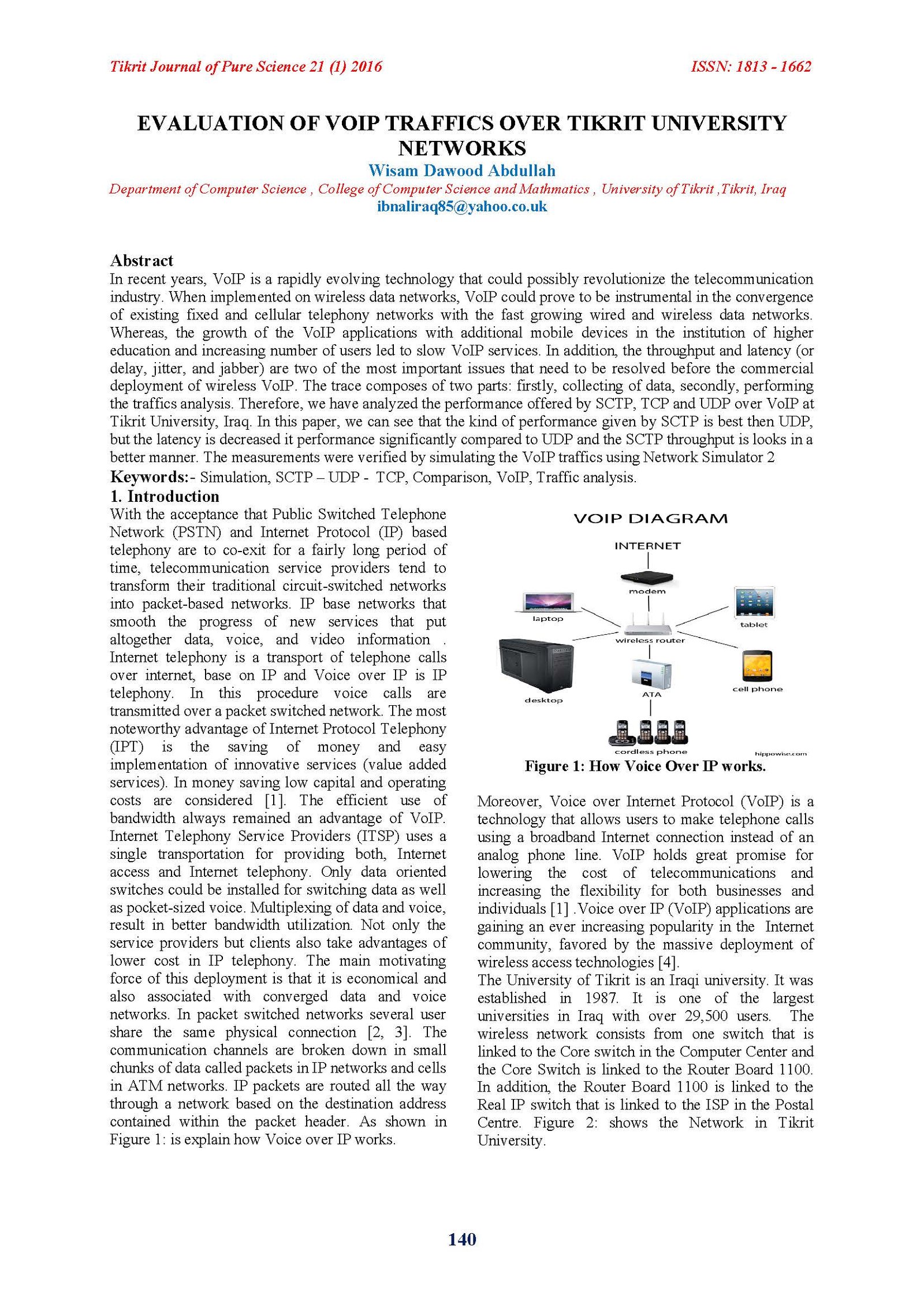EVALUATION OF VOIP TRAFFICS OVER TIKRIT UNIVERSITY NETWORKS
Main Article Content
Abstract
In recent years, VoIP is a rapidly evolving technology that could possibly revolutionize the telecommunication industry. When implemented on wireless data networks, VoIP could prove to be instrumental in the convergence of existing fixed and cellular telephony networks with the fast growing wired and wireless data networks. Whereas, the growth of the VoIP applications with additional mobile devices in the institution of higher education and increasing number of users led to slow VoIP services. In addition, the throughput and latency (or delay, jitter, and jabber) are two of the most important issues that need to be resolved before the commercial deployment of wireless VoIP. The trace composes of two parts: firstly, collecting of data, secondly, performing the traffics analysis. Therefore, we have analyzed the performance offered by SCTP, TCP and UDP over VoIP at Tikrit University, Iraq. In this paper, we can see that the kind of performance given by SCTP is best then UDP, but the latency is decreased it performance significantly compared to UDP and the SCTP throughput is looks in a better manner. The measurements were verified by simulating the VoIP traffics using Network Simulator 2
Article Details

This work is licensed under a Creative Commons Attribution 4.0 International License.
Tikrit Journal of Pure Science is licensed under the Creative Commons Attribution 4.0 International License, which allows users to copy, create extracts, abstracts, and new works from the article, alter and revise the article, and make commercial use of the article (including reuse and/or resale of the article by commercial entities), provided the user gives appropriate credit (with a link to the formal publication through the relevant DOI), provides a link to the license, indicates if changes were made, and the licensor is not represented as endorsing the use made of the work. The authors hold the copyright for their published work on the Tikrit J. Pure Sci. website, while Tikrit J. Pure Sci. is responsible for appreciate citation of their work, which is released under CC-BY-4.0, enabling the unrestricted use, distribution, and reproduction of an article in any medium, provided that the original work is properly cited.
References
[1] M. S. Zafar, "Evaluation of UDP and SCTP for SIP-T and TCP, UDP and SCTP with constant traffic," Blekinge Tekniska Högskola, 2008.
[2] T. Patel, et al., "Capacity estimation of VoIP channels on wireless networks," Dept of Electrical and Computer Engineering, The University of Texas at Austin, 2003.
[3] P. Gangurde, et al., "Simulation of TCP, UDP and SCTP with constant traffic for VOIP services," Simulation, vol. 2, pp. 1245-1248, 2012.
[4] D. Endler and M. Collier, Hacking exposed VoIP: voice over IP security secrets & solutions: McGraw-Hill, Inc., 2006.
[5] K. Pahlavan and A. H. Levesque, Wireless information networks vol. 93: John Wiley & Sons, 2005.
[6] Postel, J., "Internet Protocol," RFC 760, USC/Information Sciences Institute, January 1980.
[7] Postel, J., "Transmission Control Protocol," RFC 761, USC/Information Sciences Institute, January 1980.
[8] R. Stewart, et al., "RFC 2960: Stream Control Transport Protocol," IETF, October, 2000.
[9] T. Issariyakul and E. Hossain, Introduction to network simulator NS2: Springer Science & Business Media, 2011.
[10] W. D. Abdullah, "Characterization of Internet Traffic in UUM Wireless Networks," Universiti Utara Malaysia, 2012.
[11] M. Hassan and R. Jain, High performance TCP/IP networking vol. 29: Prentice Hall, 2003.
[12] I. A. Najm, "A Simulation Study on Amplified WiMAX and WiFi Signal of Tikrit University," Universiti Utara Malaysia, 2012.
[13] A. Kumar, et al., Wireless networking: Morgan Kaufmann, 2008.
[14] Y. Miyahara, "Next-generation wireless technologies trends for ultra low energy," in Low Power Electronics and Design (ISLPED) 2011 International Symposium on, 2011, pp. 345-345.
